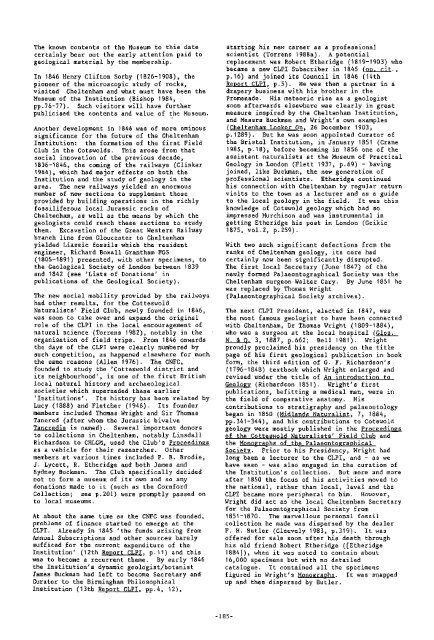Number 5 - Geological Curators Group
Number 5 - Geological Curators Group
Number 5 - Geological Curators Group
Create successful ePaper yourself
Turn your PDF publications into a flip-book with our unique Google optimized e-Paper software.
The known contents of the Museum to this datecertainly bear out the early attention paid togeological material by the membership.In 1846 Henry Clifton Sorby (1826-1908), thepioneer of the microscopic study of rocks,visited Cheltenham and what must have been theMuseum of the Institution (Bishop 1984,pp.76-77). Such visitors will have furtherpublicised the contents and value of the Museum.Another development in 1846 was of mare ominoussignificance for the future of the CheltenhamInstitution: the formation of the first FieldClub in the Cotswolds. This arose from thatsocial innovation of the previous decade,1836-1846, the coming of the railways (Clinker1964), which had major effects on both theInstitution and the study of geology in thearea. The new railways yielded an enormousnumber of new sections to supplement thoseprovided by building operations in the richlyfossiliferous local Jurassic rocks ofCheltenham, as well as the means by which thegeologists could reach these sections to studythem. Excavation of the Great Western Railwaybranch line from Gloucester to Cheltenhamyielded Liassic fossils which the residentengineer, Richard Boxall Grantham FGS(1805-1891) presented, with other specimens, tothe <strong>Geological</strong> Society of London between 1839and 1842 (see 'Lists of Donations' inpublications of the <strong>Geological</strong> Society).The new social mobility provided by the railwayshad other results, for the CotteswoldNaturalists' Field Club, newly founded in 1846,was soon to take over and expand the originalrole of the CLPI in the local encouragement ofnatural science (Torrens 1982), notably in theorganisation of field trips. From 1846 onwardsthe days of the CLPI were clearly numbered bysuch competition, as happened elsewhere for muchthe same reasons (Allen 1976). The CNFC,founded to study the 'Catteswald district andits neighbourhood', is one of the first Britishlocal natural history and archaeologicalsocieties which superseded these earlier'Institutions'. Its history has been related byLncy (1888) and Fletcher (1946). Its foundermembers included Thomas Wright and Sir ThomasTancred (after whom the Jurassic bivalveTancredia is named). Several important donorsto collections in Cheltenham, notably LinsdallRichardson to CHLGM, used the Club's Proceedingsas a vehicle for their researches. Othermembers at various times included P. B. Brodie,3. Lycett, R. Etberidge and both James andSydney Buckman. The Club specifically decidednot to form a museum of its own and so anydonations made to it (such as the CornfordCollection; see p.201) were promptly passed onto local museums.At about the same time as the CNFC was founded,problems of finance started to emerge at theCLPI. Already in 1845 'the funds arising fromAnnual Subscriptions and other sources barelysufficed for the current expenditure of theInstitution' (12th ReDort CLPI, p.11) and thiswas to become a recurrent theme. By early 1846the Institution's dynamic geologist/botanistJames Buckman had left to become Secretary andCurator to the Birmingham PhilosophicalInstitution (13th ReDort CLPI, pp.4, 12),starting his new career as a professionalscientist (Torrens 1988a). A potentialreplacement was Robert Etheridge (1819-1903) whobecame a new CLPI Subscriber in 1845 (d.p.16) and joined its Council in 1846 (14thReDort CLPI, p.5). He was then a partner in adrapery business with his brother in thePromenade. His meteoric rise as a geologistsoon afterwards elsewhere was clearly in greatmeasure inspired by the Cheltenham Institution,and Messrs Buckman and Wright's own examples(Gheltenham Looker On, 26 December 1903,p.1289). But he was soon appointed Curator ofthe Bristol Institution, in January 1851 (Crane1985, p.181, before becoming in 1856 one of theassistant naturalists at the Museum of PracticalGeology in London (Flett 1937, p.69) - havingjoined, like Buckman, the new generation ofprofessional scientists. Etheridge continuedhis connection with Cheltenham by regular returnvisits to the town as a lecturer and as a guideto the local geology in the field. It was thisknowledge of Cotswold geology which had soimpressed Murchison and was instrumental ingetting Etheridge his post in London (Geikie1875, v01.2, p.259).With two such significant defections from theranks of Cheltenham geology, its core hadcertainly now been significantly disrupted.The first local Secretary (June 1847) of thenewly formed Palaeontographical Society was theCheltenbam surgeon Walter Cary. By June 1851 hewas replaced by Thomas Wright(Palaeontographical Society archives).The next CLPI President, elected in 1847, wasthe most famous geologist to have been connectedwith Cheltenham, Dr Thomas Wright (1809-1884),who was a surgeon at the local hospital (Glos.N. 3, 1887, p.662; Bell 1981). Wrightproudly proclaimed his presidency on the titlepage of his first geological publication in bookform, the third edition of G. F. Richardson's(1796-1848) textbook which Wright enlarged andrevised under the title of An introduction toWbgy (Richardson 1851). Wright's firstpublications, befitting a medical man, were inthe field of comparative anatomy. Hiscontributions to stratigraphy and palaeontologybegan in 1850 (Midlands Naturalist, 7, 1884,pp.341-344), and his contributions to Cotswoldgeology were mostly published in the Proceedinesof the Cotteswold Naturalists' Field Club andthe Monoera~hs of the Palaeantoera~hical%s&y. Prior to his Presidency, Wright hadlong been a lecturer to the CLPI, and - as wehave seen - was also engaged in the curation ofthe Institution's collection. But more and moreafter 1850 the focus of his activities moved tothe national, rather than local, level and theCLPI became more peripheral to him. However,Wright did act as the local Cheltenham Secretaryfor the Palaeontographical Society from1851-1870. The marvellous personal fossilcollection he made was dispersed by the dealerF. H. Butler (Cleevely 1983, p.319). It wasoffered for sale soon after his death throughhis old friend Robert Etheridge ([Etheridge1884]), when it was noted to contain about16,000 specimens but with no detailedcatalogue. It contained all the specimensfigured in Wright's Monoera~hs. It was snappedup and then dispersed by Butler.
















